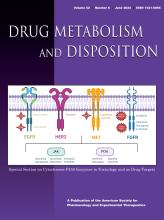Abstract
Extrapolating in vivo hepatic clearance from in vitro uptake data is a known challenge, especially for organic anion-transporting polypeptide transporter (OATP) substrates, and the well-stirred model (WSM) commonly yields systematic underpredictions for those anionic drugs, hypothetically due to “albumin-mediated hepatic drug uptake”. In the present study, we demonstrate that the WSM incorporating the dynamic free fraction (fD), a measure of drug protein binding affinity, performs reasonably well in predicting hepatic clearance of OATP substrates. For a selection of anionic drugs, including atorvastatin, fluvastatin, pravastatin, rosuvastatin, pitavastatin, cerivastatin, and repaglinide, this dynamic well-stirred model (dWSM) correctly predicts hepatic plasma clearance within 2-fold error for six out of seven OATP substrates examined. The geometric mean of clearance ratios between the predicted and the observed values falls in the range of 1.21–1.38. As expected, the WSM with unbound fraction (fu) systematically underpredicts hepatic clearance with greater than 2-fold error for five out of seven drugs, and the geometric mean of clearance ratios between the predicted and the observed values is in the range of 0.20–0.29. The results suggest that, despite its simplicity, the dWSM operates well for transporter-mediated uptake clearance, and that clearance under-prediction of OATP substrates may not necessarily be associated with the chemical class of the anionic drugs, nor is it a result of albumin-mediated hepatic drug uptake as currently hypothesized. Instead, the superior prediction power of the dWSM confirms the utility of the dynamic free fraction in clearance prediction and the importance of drug plasma binding kinetics in hepatic uptake clearance.
SIGNIFICANCE STATEMENT The traditional well-stirred model (WSM) consistently underpredicts organin anion-transporting polypeptide transporter (OATP)-mediated hepatic uptake clearance, hypothetically due to the albumin-mediated hepatic drug uptake. In this manuscript, we apply the dynamic WSM to extrapolate hepatic clearance of the OATP substrates, and our results show significant improvements in clearance prediction without assuming albumin-mediated hepatic drug uptake.
Footnotes
- Received January 4, 2024.
- Accepted March 27, 2024.
This work received no external funding.
No author has an actual or perceived conflict of interest with the contents of this article.
↵
 This article has supplemental material available at dmd.aspetjournals.org.
This article has supplemental material available at dmd.aspetjournals.org.
- Copyright © 2024 by The American Society for Pharmacology and Experimental Therapeutics
DMD articles become freely available 12 months after publication, and remain freely available for 5 years.Non-open access articles that fall outside this five year window are available only to institutional subscribers and current ASPET members, or through the article purchase feature at the bottom of the page.
|







